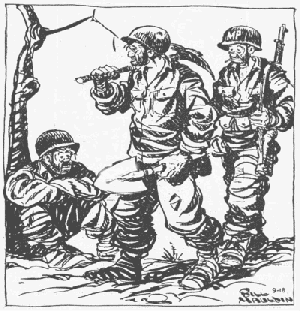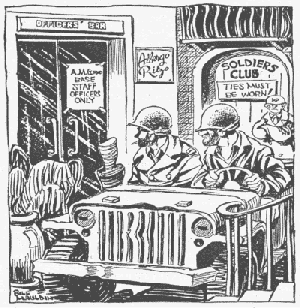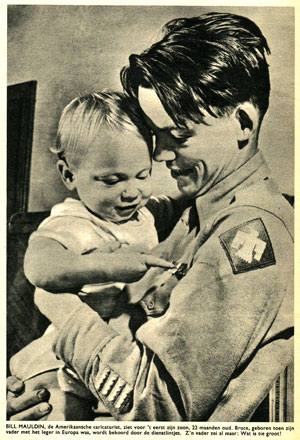'Willie and Joe'.
William Henry "Bill" Mauldin was a US cartoonist, best known for his World War II cartoons about American soldiers. Born in New Mexico, Mauldin attended the Chicago Academy of Fine Arts and fought as a sergeant in Sicily and other European battlefields. He joined the Army newsletter Stars and Stripes as a cartoonist.
'Willie and Joe'.
There he perfected 'Willie and Joe', the muddy, weary "dogfaces" who portrayed the drabness of the foot soldier's life. Despised by the conservative brass as disrespectful, but loved by the G.I.'s as one of their own, the cartoons won him a Pulitzer Prize in 1945.
'Willie and Joe'.
After the War, Mauldin abandoned cartooning for a while, working as a film actor, freelance writer, and illustrator of articles and books, including one on the Korean War. A self-styled "stirrer-upper", Mauldin joined the St. Louis Post-Dispatch in 1958 and took up cartooning again. Dubbed "the hottest editorial brush in the U.S.," he won his second Pulitzer Prize that year. His most famous editorial cartoon ran in The Chicago Daily News after the assassination of John F. Kennedy on 22 November 1963. It depicts Abraham Lincoln, seated on the throne of the Lincoln Memorial, weeping behind his hands. Mauldin heard that most newspaper salesmen sold issues of that day's paper, showing the back page (where this cartoon was printed) instead of the front page.
On 6 October 1965 he was also one of six cartoonists (the others being Milton Caniff, Roy Crane, Don Sherwood, Mort Walker and George Wunder) to be invited by U.S President Lyndon B. Johnson to the White House as "creators of military comics."
Bill Mauldin, 1945.
Bill Mauldin died at the age of 81 in Newport Beach, California on 22 January 2003. Syndicated in over 250 newspapers, Bill Mauldin battled injustice and pretense with irony and humor.
Bill Mauldin was an influence on Charles M. Schulz, Jack Davis, Pat Oliphant, Ralph Bakshi, Ray Osrin, Mike Peters and Bob Englehart.
Bill Mauldin in Italy during WW II (photo by John Phillips, © LA Times).






